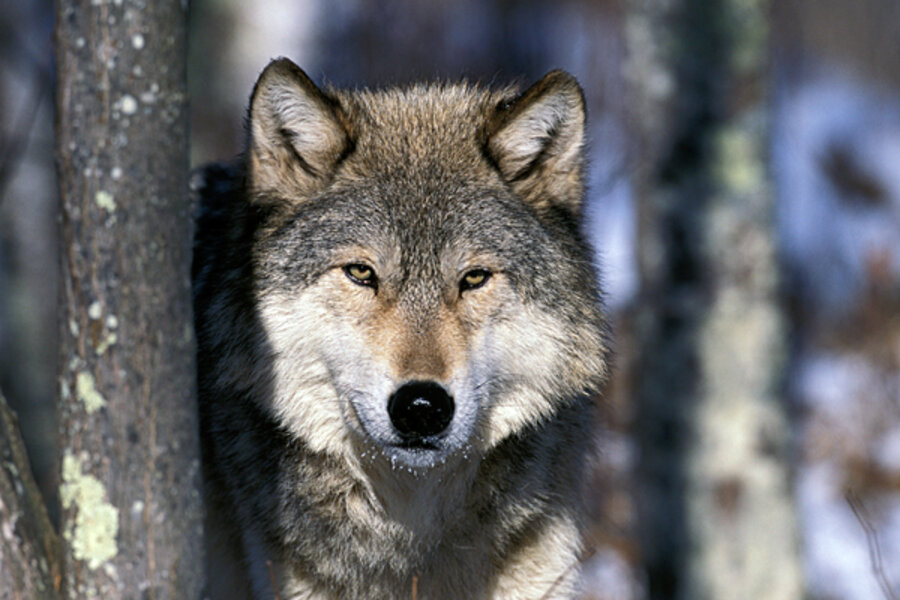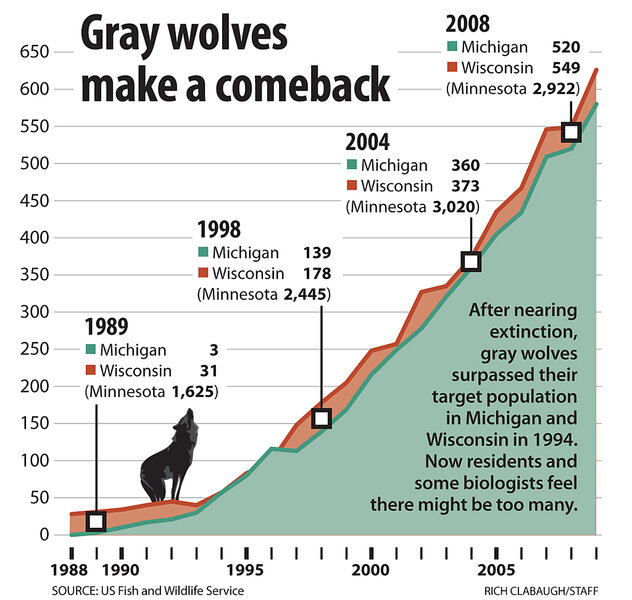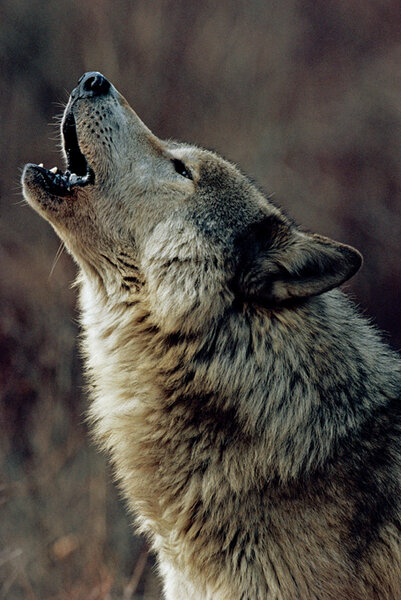Gray wolf comeback worries Midwest
Loading...
For a long time Jim Heintz, an octogenarian farmer in Bruce, Wis., gave little thought to the wolves reoccupying his state. Then his calves started disappearing.
"We didn't realize what was happening," he recalls. "Then we started hearing all these wolves. People starting seeing wolves."
That was five or six years ago. He has since seen plenty of wolves himself, including one he watched last year try to drag a dead calf from his back pasture. He estimates he's lost 20 calves to wolves over the past decade.
"If I wasn't in the business I'm in, it would be kind of nice to see a wolf occasionally," says Mr. Heintz. But the cattle farmer in him shares the growing skepticism about wolves in Wisconsin. "I don't know that the wolf really has a place in farm country," he says.
The gray wolf has made an astonishing comeback in the upper Midwest. Once extirpated from all but a remote corner of northern Minnesota, wolves have flourished under the protection of the Endangered Species Act. They have expanded across half of Minnesota, a third of Wisconsin, and all of Michigan's Upper Peninsula. Today the number of wolves in the western Great Lakes region exceeds 4,000.
That's probably too many, say wildlife biologists and much of the public. Increasingly, wolves are killing livestock, attacking dogs, and inspiring fear and hostility. Recovery efforts may have succeeded too well, straining tolerance for an animal that was once among the most exalted symbols of the environmental movement.
"There was more tolerance when numbers were low," says Ron VanderVelden, a retired schoolteacher and volunteer who monitors 10 wolf packs near his home in Wausaukee, Wis. "The magic, the feeling that used to be inspired by the wolf, is no longer there."
The wolf's success has surprised even some experts. In 1973, when the Endangered Species Act became law, biologists envisioned an eventual population of 100 wolves in northern Wisconsin and Michigan. Today wolves in the two states number well above 1,000.
"Wolf recovery has seen a gradual expansion of what we've defined as wolf habitat," says Adrian Treves, an environmental studies professor at the University of Wisconsin-Madison. "They're starting to form breeding packs in areas where we didn't think, 20 or 30 years ago, that they could."
As wolves have multiplied, they have also moved south, from sparsely populated state and national forests into farming areas. In these areas, attacks on domestic animals have risen. And although history shows few attacks on people in the United States, many residents have grown afraid of wolves. Jim Heintz's wife, Judy, has given up the long walks she once took through the fields and nearby woods.
"Sometimes when I'm walking I feel like something's watching," she says. "It's an eerie feeling. So I just don't go. I try to keep busy around the house."
State and federal wildlife authorities would like to reduce these problems by killing wolves that threaten people or livestock. They also want to confine wolves to wilder areas where they are less likely to cause conflicts. Georgia Parham, a spokeswoman for the US Fish and Wildlife Service, says the agency is working on "a biologically consistent and legally defensible approach to wolf management." Meanwhile, the agency is considering applications from Michigan and Wisconsin for limited permission to kill problem wolves.
"We believe they are best tolerated when there is some measure of control of the population," says John Erb, a state wolf biologist in Minnesota. Mr. Erb says wolves are more accepted in Minnesota than in other states in part because they are listed as threatened, not endangered, under federal law, and officials may therefore kill troublesome individuals.
But managing wolves is difficult. Twice in the past three years the US Fish and Wildlife Service has taken Great Lakes wolves off the list of threatened and endangered species. And each time, animal-protection groups have gone to court to force the wolf back on.
"In our judgment," says Howard Goldman, Minnesota state director of the Humane Society of the United States, "until the gray wolf is restored to a significant portion of its former range, we believe it must remain protected." Despite their resurgence in the northern Midwest, gray wolves occupy only 1/20th of their former range, Mr. Goldman notes. That's "far too low," he says.
The wolf's resurgence in the Great Lakes region has illustrated what Mr. Treves calls "the enormous recuperative power of nature." It has also demonstrated the animal's remarkable adaptability.
Far from the wilderness creature of the public imagination, wolves "can live just about anywhere," says L. David Mech, an eminent wolf expert with the US Geological Survey. The question is whether people will let them.
"You take the cornfields of Indiana," says Mr. Mech. "There's deer living here. That's food. That's all wolves require."
Related:







